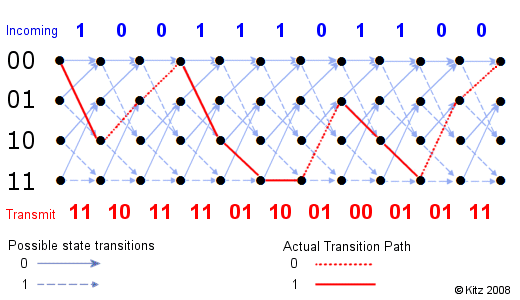 |
|
 |
| Support this site |
| |
|
| |
This tutorial looks at how adsl broadband errors are detected and the methods used to correct corrupted data. ~ Error Detection and Correction Our modems are responsible for Error Detection and Correction, which can have several different states
If no errors are detected then data can be processed and passed on to our computers, elsewise the modem decides which action to take depending on whether or not the data can be recovered.
A function that enables devices connected to the Internet to detect flawed data and request that it be retransmitted. DSL Broadband utilises error correction at different levels:
Both of these methods work independently but can be combined so that any burst type errors not corrected by convolutional coding may be caught by the block coding method. Concatenating these two different coding methods gives a high degree of correction. It's usual for the convolutional code such as TCM to be the "Inner code" whilst a block code such as RS is classed as the "Outer Code". Also applying Interleaving to the block code, in order to scatter the errors from noise bursts, gives near optimum performance.
Cyclic Redundancy Check (CRC) is a block code used for error detection only. CRC is when a special checksum code is attached to each packet of data that is transmitted. A very simplified example of a checksum would be:
At the receiving end a decoder then performs the same calculation on the data in the packet and then compares it to the transmitted CRC code. The outcome will be one of the following options:
More sophisticated CRC codes (eg HEC) can correct some number of errors. Only if the number of errors exceeds the codes correction ability will it signal a CRC erasure. A CRC type of algorithm used for checking and correcting an error in an ATM cell header. HEC has single bit error correction and multiple bit error detection capabilities. ATM equipment checks for an error and if possible will correct it. A simplified example would be
Multiple bit errors are discarded and re-requested. ~ Forward Error Correction (FEC) FEC sends additional redundant data which can be used by the decoder to check for errors and correct data without the need for retransmission. Reed Solomon (RS) coding is commonly used in Forward Error Correction and typically incurs an overhead of circa 8%. Forward Error Correction is often used in conjunction with interleaving to help stabilise adsl lines, but the redundant data will obviously carry an overhead. There are two ways of dealing with the overhead:-
ADSL uses out-of-band signals to carry redundant data for FEC whereby certain sub-channels are specifically assigned to carry the overhead data. These sub-channels are not available for transmission of normal data and used purely for FEC overheads. Assigning sub-channels as out-of-band has the effect of reducing the maximum sync speed available for normal data transmission. Reed Solomon encoding is a form of block (or algebraic) coding. Depending on the algorithm used the encoder at the sending end inserts "x" number of parity bits into the payload data. Different levels of redundancy can be applied. Obviously the more check bits that are used gives higher chance of data recovery, but will cause a higher increase in latency. Some routers will show the level applied by the DLM. eg
When data is received at the other end the decoder then converts back to the original data, and if necessary using the additional redundancy to recover any data that may have been corrupted.
TCM is a type of convolutional code which utilises parity bits on each symbol within a continuous data stream. Its also a highly efficient form of modulation for data which is to be transferred over such mediums as the telephone line. Trellis encoding works well for general background type noise. It has negligible data overheads for redundancy and instead uses complex constellations for mapping of the data path. The advantage is a higher data rate than with block encoding but it relies on the modem chipset to undertake more complex calculations and therefore a faster processor is required to avoid latency. Whilst Trellis encoding may cause a tiny amount of buffering during the encoding and decoding stage it should be negligible on most decent modems and not cause any noticeable latency. The end result should be low error rates for environments experiencing low level repetitive noise as it detects patterns from noise sources and is able to correct these. The net coding gain for TCM is said to be circa 3dB in most environments, although it must also be said it does not offer any advantage if the line is completely noise free. It should work best on longer lines which are more likely to pick up background noise from the environment.
So called because of the "trellis" like structure in which the data is encoded, data can only follow one of 2 paths in a branch like (or garden trellis type) structure. If one bit is corrupted then using this technique its possible to recalculate the missing bit of data based on the data either side of the corrupted data. If the data received had an error then the path through the trellis would be broken, but could be recalculated from the preceding and following data. Below is a simple diagram showing Trellis Coded Modulation
* In reality the code is much more complicated and can be multi-dimensional constellations which allows more data to be remapped. ~ Glossary ATM - Asynchronous Transfer Mode - Protocol used to transport data - See ATM Further reading EE4253 Digital Communications - Convolutional Coding ©kitz 2008 |
||||||||||||||||||||||
All rights reserved
Unauthorised reproduction prohibited
|
|
|
|

